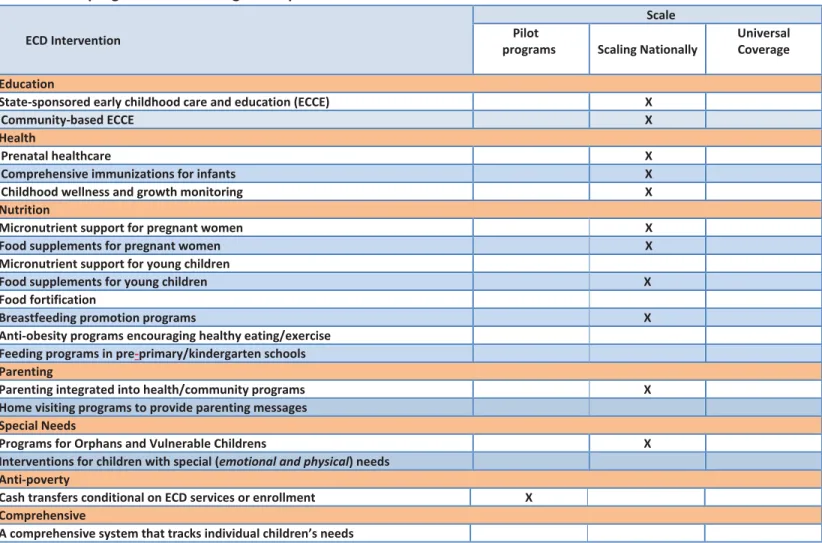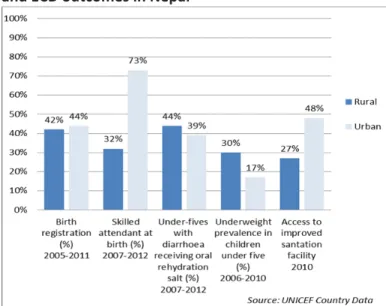Nepal
EARLY CHILDHOOD DEVELOPMENT
SABER Country Report 2013
Policy Goals Status
1. Establishing an Enabling Environment
The early childhood development system in Nepal is defined by policies,
including the early childhood development sections in the National Plan of Action 2011 and the School Sector Reform Plan. The Ministry of Education has
identified a costed five-year plan for early childhood education and development in Nepal. While a plan and some coordinating mechanisms are in place, the system should be strengthened in order to ensure effective implementation of the policy and efficient revision of multi-sectoral services at the local level.
2. Implementing Widely
Coverage levels for essential early childhood development services are
inadequate, particularly for children from the poorest families and those living in rural areas. There is currently a disconnect between the outcomes policies are designed to achieve and the reality of service delivery. ECD service delivery in all sectors should be expanded to ensure all children are provided the
opportunity for optimal development.
3. Monitoring and Assuring Quality
The government of Nepal has established adequate quality standards for early childhood development services across relevant sectors. However, well- developed and applied quality assurance mechanisms do not yet exist.
Public Disclosure AuthorizedPublic Disclosure AuthorizedPublic Disclosure AuthorizedPublic Disclosure Authorized
90088
Table1:SnapshotofECDindicatorsinNepalwithregionalcomparison
Nepal Bangladesh India Pakistan SriLanka
Infantmortality(deathsper1,000livebirths,
2010) 46 37 47 59 11
Below5mortality(deathsper1,000livebirths,
2010) 54 46 61 72 12
Below5sufferingfromstunting,moderateand
severe(percentage) 41% 41% 48% 44% 17%
Maternal mortality ratio (deaths per 100,000
births) 170 240 200 260 35
Birthregistration2005Ͳ2011 42% 10% 41% 27% 97%
GrosspreͲprimaryenrollmentrate(ages3Ͳ5) (2012)73.7 (2011)26 (2010)55 (2005)53 (2011)84
Source:UNICEFMICS,UNESCOInstituteofStatistics(2011),NepalLivingStandardSurvey,2011;DHS,2011,NepalDepartmentofEducation
1SABERͲECDisonedomainwithintheWorldBankinitiative,SystemsApproachtoBetterEducationResults(SABER),whichisdesignedtoprovidecomparableand comprehensiveassessmentsofcountrypolicies.
2WorldDevelopmentIndicatorsdatabase,WorldBank,2013.
3MinistryofFinanceEconomicSurvey,Fiscalyear2011/2012.
4DHS,2011.
ThisreportpresentsananalysisoftheEarlyChildhoodDevelopment(ECD)programsandpoliciesthataffectyoung childreninNepalandrecommendationstomoveforward.Thisreportispartofaseriesofreportspreparedbythe WorldBankusingtheSABERͲECDframework1andincludesanalysisofearlylearning,health,nutrition,andsocialand childprotectionpoliciesandinterventionsinNepal,alongwithregionalandinternationalcomparisons.
NepalandEarlyChildhoodDevelopment
Nestled between China and India, the Federal DemocraticRepublicofNepalisageographicallydiverse andculturallyrichnation,withtheworld’shighestpeak anddiversegeography,includingtheruggedHimalayas in the northandthe flatriver plainsinthesouth.
According to the National Population and Housing Census(2011),Nepalishometo26.5millionpeople, 81%of whompracticeHinduism.Nearly15percent (3,858,137)ofthepopulationis6yearsoldoryounger.
Nepalisthe105thlargesteconomyintheworld,witha GDPofUS$19.4billion.2Thecountryhasexperienced economicgrowthof4.3percentand3percentin2010 and2011,respectively.3TwoͲthirdsofthepopulationis
employedintheagricultureindustry,whichaccountsfor morethanoneͲthirdofthecountry’seconomy.Despite strongeconomicgrowthinrecentyears,oneͲquarterof thepopulationislivingbelowthepovertyline.
Since 1990, Nepal has reduced the rates of infant mortalityandunderͲ5mortalityby46percentand54 percent,respectively.4Inrecentyears,thegovernment has placed increased importance on early childhood development(ECD),asexemplifiedbythedevelopment ofthe2011NationalPlanofAction,whichisanimportant steptowardsachievinguniversal,highqualityECDforall children.Despitethisprogress,manychildreninNepaldo nothaveaccesstocomprehensive,qualityECDservices.
SYSTEMSAPPROACHFORBETTEREDUCATIONRESULTS 3
SystemsApproachtoBetterEducation Results–EarlyChildhoodDevelopment (SABERǦECD)
SABER–ECD collects, analyzes, and disseminates comprehensiveinformationonECDpoliciesaroundthe world.Ineachparticipatingcountry,extensivemultiͲ sectoralinformationiscollectedonECDpoliciesand programs through a desk review of available government documents, data and literature, and interviewswitharangeofECDstakeholders,including government officials,service providers, civil society, developmentpartners,andscholars.TheSABERͲECD framework presents a holistic and integrated assessmentofhowtheoverallpolicyenvironmentina country affects young children’s development. This assessment can be used to identify how countries addressthesamepolicychallengesrelatedtoECD,with the ultimate goalofdesigningeffectivepoliciesfor youngchildrenandtheirfamilies.
Box1presentsanabbreviatedlistofinterventionsand policies that the SABERͲECD approach looks for in countries when assessing the level of ECD policy development.Thislistisnotexhaustive,butismeantto provideaninitialchecklistforcountriestoconsiderthe keypoliciesandinterventionsneededacrosssectors.
SABERͲECD identifies three core policy goals that countries should address to ensure optimal ECD outcomes: Establishing an Enabling Environment, Implementing Widely, and Monitoring and Assuring Quality.ImprovingECDrequiresanintegratedapproach toaddressallthreegoals.AsdescribedinFigure1,for eachpolicygoal,aseriesofpolicylevershavebeen identified, through which decisionͲmakers can strengthenECD.
Strengthening ECD policies can be viewed as a continuum;asdescribedinTable2onthefollowing page,countriescanrangefromalatenttoadvanced levelofdevelopmentwithinthedifferentpolicylevers andgoals.
Box1:AchecklisttoconsiderhowwellECDis promotedatthecountrylevel
Whatshouldbeinplaceatthecountryleveltopromote coordinatedandintegratedECDinterventionsforyoung
childrenandtheirfamilies?
Healthcare
x Standardhealthscreeningsforpregnantwomen x Skilledattendantsatdelivery
x Childhoodimmunizations x WellͲchildvisits
Nutrition
x Breastfeedingpromotion x Saltiodization
x Ironfortification EarlyLearning
x Parentingprograms(duringpregnancy,afterdelivery,and throughoutearlychildhood)
x Childcareforworkingparents(ofhighquality)
x FreepreͲprimaryschool(preferablyatleasttwoyears with developmentally appropriate curriculum and classrooms,andqualityassurancemechanisms)
SocialProtection
x Servicesfororphansandvulnerablechildren
x Policiestoprotectrightsofchildrenwithspecialneeds andpromotetheirparticipation/accesstoECDservices x Financial transfer mechanisms or income supports to
reachthemostvulnerablefamilies(couldincludecash transfers,socialwelfare,etc.)
ChildProtection
x Mandatedbirthregistration
x Jobprotectionandbreastfeedingbreaksfornewmothers x Specificprovisionsinjudicialsystemforyoungchildren x Guaranteedpaidparentalleaveofatleastsixmonths x Domesticviolencelawsandenforcement
x Trackingofchildabuse(especiallyforyoungchildren) x Trainingforlawenforcementofficersinregardstothe
particularneedsofyoungchildren
Figure 1: Three core ECD policy goals
Table2:Earlychildhooddevelopmentpolicygoalsandlevelsofdevelopment
ECDPolicy Goal
LevelofDevelopment
Establishing anEnabling Environment
NonͲexistentlegal framework;adͲhoc financing;lowinterͲ sectoralcoordination.
Minimallegalframework;
someprogramswith sustainedfinancing;
someinterͲsectoral coordination.
Regulationsinsome sectors;functioninginterͲ sectoralcoordination;
sustainedfinancing.
Developedlegal
framework;robustinterͲ institutional
coordination;sustained financing.
Implementing Widely
Lowcoverage;pilot programsinsome sectors;highinequalityin accessandoutcomes.
Coverageexpandingbut gapsremain;programs establishedinafew sectors;inequalityin accessandoutcomes.
NearͲuniversalcoverage insomesectors;
establishedprogramsin mostsectors;low inequalityinaccess.
Universalcoverage;
comprehensivestrategies acrosssectors;integrated servicesforall,some tailoredandtargeted.
Monitoring andAssuring
Quality
Minimalsurveydata available;limited
standardsforprovisionof ECDservices;no
enforcement.
Informationonoutcomes atnationallevel;
standardsforservices existinsomesectors;no systemtomonitor compliance.
Informationonoutcomes atnational,regional,and locallevels;standardsfor servicesexistformost sectors;systeminplace toregularlymonitor compliance.
Informationonoutcomes fromnationalto
individuallevels;
standardsexistforall sectors;systeminplace toregularlymonitorand enforcecompliance.
Policy Goal 1: Establishing an Enabling Environment
¾PolicyLevers:LegalFramework•
IntersectoralCoordination•Finance
An enabling environment is the foundation for the designandimplementationofeffectiveECDpolicies.5It consistsofthefollowing:theexistenceofanadequate legal and regulatory framework to support ECD;
coordinationwithinsectorsandacrossinstitutionsto deliverserviceseffectively;andsufficientfiscalresources withtransparentandefficientallocationmechanisms.
The legal framework comprises all of the laws and regulationsthatcanaffectthedevelopmentofyoung childreninacountry.Thelawsandregulationsimpacting ECDarediverseduetothearrayofsectorsthatinfluence ECDandbecauseofthedifferentconstituenciesthatECD policycanandshouldtarget,includingpregnantwomen, youngchildren,parents,andcaregivers
.National laws promote appropriate dietary consumptionforyoungchildren.Nepalhasastrongset oflawsandregulationsthatpromoteprenatalandearly
5Brinkerhoff,2009;Britto,Yoshikawa&Boller,2011;VargasͲBaron,2005.
nutrition.In1998,TheFoodAct2055waspassedto provide voluntary guidelines to encourage salt iodizationandinAugust2011anotificationwaspassed under theexistingFood Act makingfortificationof staples such wheat, maize, and rice mandatory.
Furthermore,theSubstituteoftheBreastMilk(Sale, DistributionandControl)Act2049enshrinesinlawthe guidelines set forth in the International Code of MarketingofBreastMilkSubstitutes.
Healthcareforpregnantwomenandyoungchildrenis aconcernofthenationalgovernment.Nepalhastaken stepstoensurethegoodhealthofyoungchildrenby requiringthatallchildrenreceiveacompletecourseof recommended childhood immunizations. WellͲchild visits, which evaluate a child’s general health and development,arenotmandated,butaremadewidely available.IntheSecondLongͲtermHealthPlan(1997Ͳ PolicyLever1.1:
LegalFramework
Table 3: Regional comparison of maternity and paternityleavepolicies
Nepal Bangladesh India Pakistan 52days,
100%pay, coveredby employer
112days, 100%pay, coveredby employer
84days, 100%pay, coveredby employer andSocial Security
84days, 100%pay, coveredby employer
Source:ILO,2012
2017),thegovernmentoutlinesgoalstoreducechild
andmothermortalityrates.Nepal’sSafeMotherhood Program,coordinatedbytheMinistryofHealth(MoH), isdesignedtoreducematernalmortalitybyincreasing access to family planning, essential obstetric and neonatalcare,andaccesstoskilledbirthattendants.
Currently,therearenolaws,regulations,orpolicies encouragingpregnantwomentohavestandardhealth screeningsforHIVandSTDs.
Policiesprovidepartial job protectionto pregnant womenandnewmothers.TheLaborAct(1992)states thatemployersarerequiredtoprovidebreaktimefor nursingmothers.LaborRules1993stipulatethatall mothersworkinginthepublicorprivatesectorare entitledto52daysofpaidmaternityleaveat100 percentoftheirsalary.Thisispaidbytheemployer.
Table3presentsmaternityleavepoliciesinselected SouthAsiancountries.Asdemonstratedinthetable, Nepalcurrentlyhastheshortestminimummaternity leaveintheregion.SimilartoBangladesh,India,and Pakistan, Nepal does not have a policy stipulating paternityleaveforfathers.However,theLaborRules 1993statethatafewdaysofleavearegrantedtotake careofthespouse.
Whilesomeprotectionisprovidedformothers,Nepal doesnotguaranteecompletejobprotectionandnonͲ discrimination for mothers in accordance with ILO MaternityProtectionConvention.Currently,nopolicy penalizesorpreventsthedismissalofpregnantwomen norobligatesemployerstogiveemployeesthesame jobwhentheyreturnfrommaternityleave.
PreͲprimaryeducationisavailableforchildrenaged 36Ͳ59monthsbutisnotmandatoryinNepal.PreͲ primaryschoolisnotcompulsoryinNepal.TheLocal SelfͲgovernanceAct(1999)givestheauthorityofpreͲ primaryeducationtolocalbodies.TheActstatesthat VillageDevelopmentCommitteesandmunicipalitiesare toestablishandmanagepreschoolswiththeirown resources.PreͲprimaryeducationispartoftheformal educationsystem;howeveritisnotrequiredofall studentswhogothroughgrades1Ͳ12.TheEducation Act(2028)identifiestwoformsofearlychildhoodcare and education (ECCE): preͲprimary classes basedin schoolsaretargetedprimarilyforchildrenages4and5.
Someof these preͲprimary classes are private and charge fees, but many public schools (community schools)nowofferECCEclasses,whichdonotcharge fees.ThesecondtypeofECCEischilddevelopment centers,whicharecommunityͲbasedandareprimarily
targetedtowardschildrenbelow4years.Thecenters arefreeofchargeandreceivetechnicalsupportfrom the Department of Education (DoE)—the executive departmentoftheMinistryofEducation(MoE)—and DistrictEducationOffices.
IntheSchoolSectorReformPlan(2009Ͳ2015),theDoE setforthitsplanstoexpandEarlyChildhoodEducation andDevelopment(ECED)6programincollaborationwith communityͲbased organizations and international NGOs.ThePlanstatesthatthegovernmentwillfund oneyearofECEDprogrammingfor4ͲyearͲoldchildren.
Communities can mobilize their own resources to provideECEDservicesforchildrenbelowthespecified agegroup.Itsetsatargetof87percentof4ͲyearͲolds enrolledinECED.
Childandsocialprotectionpoliciesareestablishedin Nepal.ChildrenAct1992providesthefoundationfor safetyandprotectionofchildreninNepal.Inadditionto mandatingtheregistrationofchildrenat birth,the ChildrenAct1992ensurestheprotectionofchildren withinthenationaljudicialsystem.Thisincludesspecific childprotectiontrainingforjudges,lawyers,andlaw enforcementofficers,andthecreationofaspecialized bodytoadvocateforchildprotection.Furthermore,the National Child Policy guarantees orphans and vulnerablechildrenwithaccesstoECDservicesand childrenwithdisabilitiesandspecialneedsareprovided supportandaccesstocrossͲsectoralservices.
6TherearevariationsintheexactdefinitionofEarlyChildhoodDevelopment betweenorganizations,academics,practitioners,andcountries.InNepal, EarlychildhoodEducationandDevelopment(ECED)referstointerventions forearlychildhoodspecificallyintheeducationsector,whereasECDcaptures crossͲsectoralservices.
x NationalChildPolicy x ChildrenAct,1992
x ECEDgoalinEFANationalPlanofAction x SchoolSectorReformPlan(2009Ͳ2015) x
x FoodAct,1998 x LaborAct,1992 x LaborRules,1993
x SubstituteoftheBreastMilkAct2049 x SecondLongͲtermHealthPlan(1997Ͳ2017)
PolicyLever1.2:
IntersectoralCoordination
Developmentinearlychildhoodisamultidimensional process.7In order to meet children’s diverse needs during the early years, government coordination is essential,bothhorizontallyacrossdifferentsectorsas wellasverticallyfromthelocaltonationallevels.In manycountries,nonͲstateactors(eitherdomesticor international)participateinECDservicedelivery;forthis reason,mechanismstocoordinatewithnonͲstateactors arealsoessential.
ThegovernmentofNepalhasanECEDstrategyand costedimplementationplan.IntheEducationforAll (EFA)NationalPlanofAction(2003),thegovernmentof Nepal and UNESCO outlined its strategy for the developmentofpoliciesandprogramsformanaging and financing ECED. It sets the ambitious goals of expandingcoverageandefficacyofservicessothatall childrenareprovidedcomprehensiveECEDservices.
AspredicatedbytheEFANationalPlanofAction,the DoEincludedECEDinitsSchoolSectorReform(SSR) Plan (2009Ͳ2015). The MoE outlined a clear multiͲ sectoral strategy for ECED and a fiveͲyear implementation plan, estimated to cost US$62.9 million.Whiletheplanisheavilyfocusedineducation,it includesstrategiesforcoordinationarrangementswith theMoH,MinistryofLocalDevelopment(MoLD),and Ministry of Women, Children, and Social Welfare (MoWCSW).
Aninstitutionalanchorexistsatthenationallevelto coordinateECDactivities.In2005,theEarlyChildhood DevelopmentCouncilwasestablishedto coordinate ECD activities and synergies across all sectors. The councilischairedbytheMoEandhasrepresentatives fromtheMoH,MoLD,MoWCSW,UNagencies,and NGOs.The main responsibility of the council is to ensurecoordinationofECDactivitiesamongnational and local level programs. Figure 2 displays the institutional arrangements of the council. In some districts,DistrictChildDevelopmentBoardshavebeen established to ensure community participation and coordinatewithlocalauthorities.Whiletheseboardsdo notyetexistinall75districts,thereareplanstoensure thatalldistrictsinNepalhavetheselocalboards.
7Naudeauetal.,2011;UNESCOͲOREALC,2004;Neuman,2007.
Figure2:InstitutionalArrangementsofECDCouncil
NationalECDstrategyemphasizescoordinationwith communities.TheEFANationalPlanofActionhighlights acommunityͲbasedapproachforimplementationfor ECD programs. Local bodies are to be delegated authorityofmanagingECDcenters.Theplanstatesthat Village Development Committees (VDCs) and municipalities should each be responsible for establishingandoperatingcenterswithfinancialand technicalsupportfromthenationalgovernment.
Interventionscouldbebettercoordinatedatthepoint ofservicedelivery.WhiletheSSRPlanestablishesa strong framework for coordination of education servicesforyoungchildren,thecoordinationacrossall relevant sectors could be strengthened. The governmentdoesnotcurrentlyhavean established menuofintegratedservicestobeprovidedtochildren.
Agreeingon a common plan of action through an integratedservicedeliverymanualcouldimproveinterͲ sectoralcoordinationinNepal.
PolicyLever1.3:
Finance
Whilelegalframeworksandintersectoralcoordination arecrucialtoestablishinganenablingenvironmentfor ECD,adequatefinancialinvestmentiskeytoensurethat resources are available to implement policies and achieveserviceprovisiongoals.InvestmentsinECDcan yieldhighpublicreturns,butareoftenundersupplied withoutgovernmentsupport.Investmentsduringthe earlyyearscanyieldgreaterreturnsthanequivalent investmentsmadelaterinachild’slifecycleandcan leadtolongͲlastingintergenerationalbenefits.8Notonly doinvestmentsinECDgeneratehighandpersistent returns,theycanalsoenhancetheeffectivenessofother social investments and help governments address multipleprioritieswithsingleinvestments.
ThegovernmentreportspublicECDexpenditures,but determiningthebudgetisnotacoordinatedeffort acrossministries.FinancingofECDinNepalisachieved throughbothpublicandnonͲpubliccontributions.Table
8Valerio&Garcia,2012;WHO,2005;Hanushek&Kimko,2000;Hanushek&
Luque,2003.
4 displays the national budgetsrelatedto ECDfor
education,health,andnutritionin2009and2010.No dataareavailablepertainingtotheleveloffinancing,or onthecoordinationoffundingbetweenbilateralaid partners and other stakeholders. The Financial ComptrollerGeneralOfficetracksexpendituresacross the sectors. However, the budget for specific ECD expendituresisnotdeterminedthroughcoordinated efforts across ministries, which could be a more efficient and costͲeffective strategy. In order to benchmark and assess the level of public sector financialcommitmenttoECD,itwouldbeparticularly helpfultodisaggregatefinancialdatabyagecohort, fundingmechanism,andallocation.
Table4:ECDbudgetacrosssectorsinNepal,bysector
2010 2009
Education 680,365,000NPR 633,564,000NPR
Health 981,303,000NPR 941,068,000NPR
Nutrition 842,055,000NPR 281,613,000NPR
Source:MinistryofEducation;MinistryofHealthNutritionandPopulation;
MinistryofWomen,Children,andSocialWelfare.
ThelevelofECDfinanceisnotadequatetomeetthe needsofthepopulation.In2011,5percentofthe annualeducationbudgetwasallocatedtowardspreͲ primaryeducation(UNESCO,2011).Thisrepresentsless than0.1percentofGDP.TheOECDsuggeststhatpublic investmentsrepresentaminimumof1percentofGDP toensurequalityearlychildhoodcareandeducation services.
Table 5 presents a regional comparison of health expenditure indicators. In 2007, the Interim Constitution2063waspassed,guaranteeingfreebasic healthcareforpregnantwomenandyoungchildren.
However,asof2011,only20percentofroutineEPI vaccineswerefinancedbythegovernment,andthe remainder by nonͲgovernmentsources.Additionally, outͲofͲpocketexpenditures9accountfor83percentof allprivatehealthexpenditures.Althoughthedataare notspecifictoECDͲagedchildrenorpregnantwomen, thehighrateofoutͲofͲpocketexpenditureindicates
9OutͲofͲpocketexpenditureisanydirectoutlaybyhouseholds, includinggratuitiesandinͲkindpayments,tohealthpractitioners andsuppliersofpharmaceuticals,therapeuticappliances,andother goodsandserviceswhoseprimaryintentistocontributetothe restorationorenhancementofthehealthstatusofindividualsor populationgroups.
that,despitepolicysuggesting otherwise,thereare privatecostsassociatedwithhealthservices.Atthe regionallevel,outͲofͲpocketexpenditureisrelatively comparable to other countries. However, total expenditureonhealthpercapitaislessthanhalfofthat for India and Sri Lanka, but more than that for BangladeshandPakistan.
Table5:Regionalcomparisonofselecthealth expenditureindicators
Nepal Bangladesh India Pakistan Sri
Lanka OutͲofͲpocket
expenditureasa percentageofallprivate healthexpenditure
83% 97% 86% 82% 81%
OutͲofͲpocket expenditureasa percentageoftotal healthexpenditures
48% 63% 61% 50% 45%
Totalexpenditureon healthpercapita(2009, adjustedforpurchasing powerparity)
US$
63 US$24 US$
132 US$
59
US$
148
RoutineEPIvaccines financedbygovernment, 2011
20% 29% 100% 100% 57%
Source:WHOGlobalHealthExpenditureDatabase,2012.
PolicyOptionstoStrengthentheEnabling EnvironmentforECDinNepal
ǣ
¾ Thegovernmentcouldconsiderexpandingmaternity benefits beyond 52 paid days and establishing provisionsforparentalleave.Itisrecommendedto follow the guidelines established by ILO Maternity ProtectionConventiontoguaranteejobprotectionand nonͲdiscrimination to pregnant women and new mothers.CountriessuchasBrazilandChile,whichhave madesubstantialstridesinrecentyearstoimprove theirECDsystem,provide120and90daysofpaid maternity leave, respectively. Sweden provides 480 daysofpaidparentalleave,60ofwhicharedesignated forboththemotherandthefather,andtheremaining 360dayscanbeallocatedat thediscretionof the parents.
¾ ThegovernmentshouldalsoconsiderrequiringwellͲ childvisitsto ensureadequatehealthcoveragefor youngchildren.ThiscouldreducetheinfantandunderͲ 5mortalityinthecountry.
ǣ
¾ TheECEDplanintheSchoolSectorReformplanis commendable.Havingaspecificimplementationplan andallocatedbudgetareessentialstepstoensurethis strategyisfollowed.Itwouldbebeneficialtoexpand thisstrategytoplacegreateremphasisonothersectors.
Aneffectiveearlychildhoodstrategyshouldcatertothe holistic needs of children’s development. Close coordination in planning, budgeting, and implementationwiththeMoH,MoWCSW,andMoLD willbecrucial.
The government can also make continued efforts alreadyoutlinedintheECDstrategytoensurethatall 75districtshaveDistrictChildDevelopmentBoardsto coordinatewithlocalgovernmentbodiesandsupport local implementation of a national ECD strategy.
Establishing integrated service delivery guidelines wouldalsoimprovecoordinationbothacrosssectorsas wellasacrosslevelsofgovernment.
ǣ
¾ Inordertodevelopaneffectivesystemthatprovides eachchildwiththeservicesandsystemrequiredto ensuretheirsafeandfulldevelopment,itiscriticalto develop mechanisms for consistent and predictable revenue streams, and a budget that disaggregates spendingbyECDagegroup,ideallybychildrenaged0Ͳ2, 3Ͳ4, and 5Ͳ6. This would enable policymakers to evaluatetheequityofinvestmentandlinkallocationsto resultͲbasedplanstopromoteaccountabilityanddirect investmenttowardsthoseinterventionsthathavethe highestimpactonchildren.
PolicyGoal2:ImplementingWidely
¾PolicyLevers:ScopeofPrograms•
Coverage•Equity
Implementing Widely refers to the scope of ECD programsavailable,theextentofcoverage(asashare oftheeligiblepopulation),andthedegreeofequity withinECDserviceprovision.Bydefinition,afocuson ECDinvolves(ataminimum)interventionsinhealth, nutrition,education,andsocialandchildprotection,and shouldtargetpregnantwomen,youngchildren,and theirparentsandcaregivers.ArobustECDpolicyshould include programs in all essential sectors, providing comparable coverage and equitable access across regionsandsocioeconomicstatus–especiallyreaching the most disadvantaged young children and their families.
PolicyLever2.1:
ScopeofPrograms
EffectiveECDsystemshaveprogramsestablishedinall essential sectors and ensure that every child and expectant mothers have guaranteed access to the essentialservicesandinterventionstheyneedtolive healthfully.Thescopeofprogramsassessestheextent towhichECDprogramsacrosskeysectorsreachall beneficiaries.Figure3presentsasummaryofthekey interventionsneededto supportyoungchildren and theirfamiliesviadifferentsectorsatdifferentstagesina child’slife.
ECDprogramsareestablishedincoreECDareasof focusandtargetallrelevantbeneficiarygroups.Nepal hasECDprogramsestablishedineachofthecriticalECD sectors: education, health, nutrition, and child protection.Withinthese,thereareprogramsthattarget thethreemainECDgroups–childrenaged0to72 months, pregnant women, and caregivers. Figure 4 shows a selection of some of the existing ECD interventions in Nepal, including sectoral, crossͲ sectoral,andmultiͲsectoralinterventions.
WhileFigure4displayssomeofthemostimportantECD programsinNepal,itdoesnotconveyinformationon thecoverageoftheseprograms.Table6showsthata rangeofECDprogramsinNepalareestablishedin health,education,andnutrition;whilecoverageisnot yetuniversal,programsarescalingnationally(seethird column of “Scale”). No programs are currently establishedtopromotepositiveparenting,andthere are no cash transfer programs that target young childrenorareconditionalonenrollmentinECD.There is,however,aprovisionforunconditionalcashtransfer programsinseveralareasthatareyettobescaledup.
Nepaldoesnothaveacomprehensivesysteminplace to track individual children’s needs and, where necessary,intervene.
Figure3:Essentialinterventionsduringdifferentperiodsofyoungchildren's
Figure4:ECDprogramsinNepal





